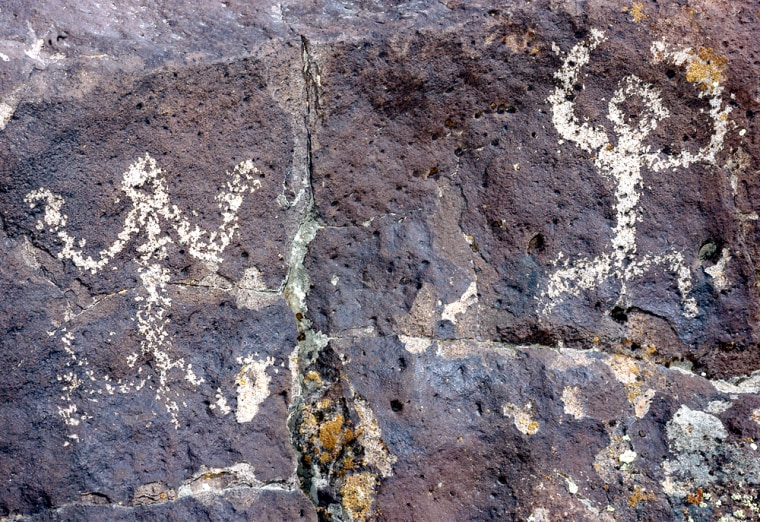Mysterious petroglyphs etched in hundreds of volcanic boulders east of Reno have survived the elements for centuries. Volunteers are now hoping the artifacts will survive the ravages of modern man.
The American Indian artwork — depicting bighorn sheep and stick-people figures — is endangered by vandals and collectors as Nevada’s sprawling growth and a soaring number of off-road vehicles have taken civilization to the doorstep of once remote backcountry sites.
The volunteers are mobilizing to preserve the 4,000-year-old site in a corner of the parched Pah Rah Range claimed by the Paiute and Washoe tribes. They also are expanding their efforts across the state.
“People are getting tired of a few people wrecking things that we love about Nevada,” said Alanah Woody, an anthropologist at the Nevada State Museum and the executive director of the Nevada Rock Art Foundation. “We’re serious about making people stop this.”
Citizen groups step up
Woody’s 400-member group plans to record Nevada’s more than 1,000 rock art sites and set up a network of volunteers to ward off looters. Citizens groups like his — along with tribes and federal agencies across the West — are stepping up efforts to protect remote archaeological sites from thieves and vandals.
Among other measures, the Bureau of Land Management plans to extend a higher level of federal protection to designated sensitive areas, qualifying them for extra law enforcement patrols, agency archaeologist Pat Barker said.
Looting is widespread across the nation due to professionals looking for a big payday, particularly in the West, said Frank McManamon, chief archaeologist for the Park Service in Washington, D.C.
“I think the cases are on the upswing,” McManamon said. “But I think what we hear about is only the tip of the iceberg. These crimes often take place in remote areas like Nevada where they go undetected.”
Looting cases increasing
The number of prosecutions for looting on federal lands averaged 230 a year from 1998 to 2001, almost four times the number from 1984 to 1998, the National Park Service reported.
One of the largest archaeological cases ever investigated involved a five-member ring convicted of stealing more than 11,000 artifacts primarily in southern Nevada from 1997 to 2001.
Its ringleader, Bobbie Wilkie, of Oklahoma City, was sentenced to three years in federal prison in December — the longest term ever for a first-time offender of the Archaeological Resources Protection Act.
In another case, Jack Harelson of Grants Pass, Ore., is accused of stealing more than 2,000 relics from a cave in northern Nevada’s Black Rock Desert in the early 1980s. In April, Harelson lost a bid to overturn a $2.5 million fine — the fourth largest ever assessed for archaeological theft.
Among artifacts taken by looters were the bodies of a young boy and girl, and 10,000-year-old sandals that possibly were the oldest footwear found on Earth.
Recently, two men were tried in federal court in Reno and convicted of stealing government property after two boulders bearing petroglyphs were found used as landscape ornaments in one of the men’s front yards.
Arlan Melendez, chairman of the Reno-Sparks Indian Colony, said tribal members are outraged and want more done to thwart thefts. Some tribes have closed archaeological sites on reservations to the public.
“We’re appalled at what’s happening to sacred sites,” Melendez said. “They remind us of where we came from and stimulate our mind as to what it was like before.”
With only 18 rangers for the 48 million acres it manages in Nevada — 67 percent of the state — the BLM acknowledges it can’t fight looting alone.
Getting the public involved
That’s why the BLM and other federal agencies are trying to set up site stewardship programs statewide and hiring a full-time coordinator to oversee the programs.
Having volunteers monitor sensitive sites has proved successful in other states, said Mark Michel, president of the Archaeological Conservancy based in Albuquerque, N.M. His preservation group acquires archaeological sites on private property.
“With the tight federal budget, it’s a trend to get the public involved to protect resources,” Michel said. “A lot of other states are putting them in place, too. The only problem is that the more remote the place is, the more difficult it is to monitor.”
Archaeologists praised prosecutors and judges for aggressively pursuing cases against looters, saying they sent a strong message that it won’t be tolerated.
“This is a crime against history,” said Fred Frampton, a U.S. Forest Service archaeologist. “It’s like tearing the pages out of a history book not yet written.”
